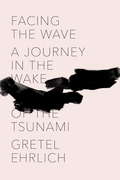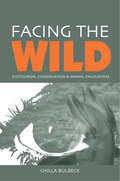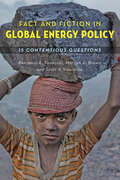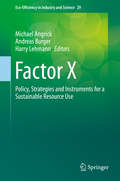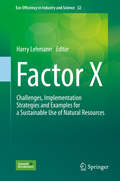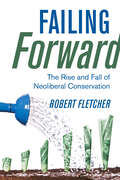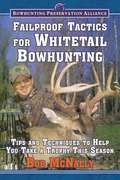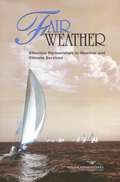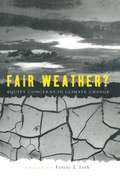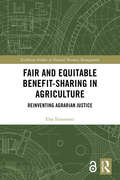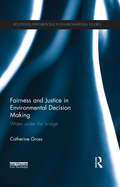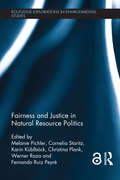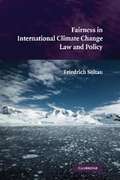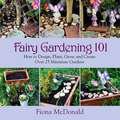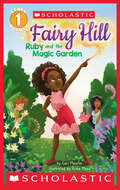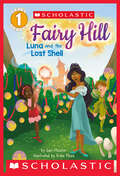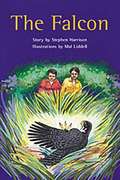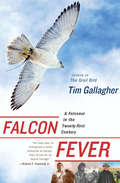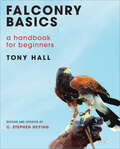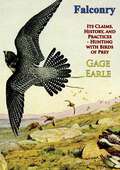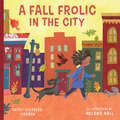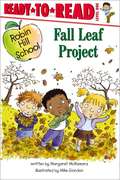- Table View
- List View
Facing the Wave: A Journey in the Wake of the Tsunami
by Gretel EhrlichA passionate student of Japanese poetry, theater, and art for much of her life, Gretel Ehrlich felt compelled to return to the earthquake-and-tsunami-devastated Tohoku coast to bear witness, listen to survivors, and experience their terror and exhilaration in villages and towns where all shelter and hope seemed lost. In an eloquent narrative that blends strong reportage, poetic observation, and deeply felt reflection, she takes us into the upside-down world of northeastern Japan, where nothing is certain and where the boundaries between living and dying have been erased by water. The stories of rice farmers, monks, and wanderers; of fishermen who drove their boats up the steep wall of the wave; and of an eighty-four-year-old geisha who survived the tsunami to hand down a song that only she still remembered are both harrowing and inspirational. Facing death, facing life, and coming to terms with impermanence are equally compelling in a landscape of surreal desolation, as the ghostly specter of Fukushima Daiichi, the nuclear power complex, spews radiation into the ocean and air. Facing the Wave is a testament to the buoyancy, spirit, humor, and strong-mindedness of those who must find their way in a suddenly shattered world.
Facing the Wild: Ecotourism, Conservation and Animal Encounters
by Chilla BulbeckWhat do wild animals mean to humans? Will they survive both rampant habitat loss and extinction caused by human encroachment and, as ecotourists, our enthusiasm for them? With ecotourism now the fastest growing segment of tourism, and encounters with wild animals - be it swimming with dolphins, going on safari or bird watching - ever more popular, these are critical questions. Yet until now little has been known about why people crave encounters with wild animals and the meaning for the ecotourism industry, conservation efforts and society at large. Facing the Wild is the first serious empirical examination of why people seek out animals in their natural environment, what the desire for this experience tells us about the meanings of animals, nature, authenticity and wilderness in contemporary industrialized societies, and whether visitors change their environmental perspectives and behaviour, as the custodians of wildlife parks would like them to. The book explores the contradictions and ambivalence that so many people experience in the presence of 'wild nature' - in loving it we may diminish it and in the act of wanting to see it we may destroy it. Ultimately the book makes a case for 'respectful stewardship' of a 'hybrid nature' and provides insight for both practitioners and ecotourists alike.
Fact and Fiction in Global Energy Policy: Fifteen Contentious Questions
by Benjamin K. Sovacool Marilyn A. Brown Scott V. ValentineA balanced examination of global energy issues.Energy sustainability and climate change are two of the greatest challenges facing humankind. Unraveling these complex and interconnected issues demands careful and objective assessment. Fact and Fiction in Global Energy Policy aims to change the prevailing discourse by examining fifteen core energy questions from a variety of perspectives, demonstrating how, for each of them, no clear-cut answer exists.Is industry the chief energy villain? Can we sustainably feed and fuel the planet at the same time? Is nuclear energy worth the risk? Should geoengineering be outlawed? Touching on pollution, climate mitigation and adaptation, energy efficiency, government intervention, and energy security, the authors explore interrelated concepts of law, philosophy, ethics, technology, economics, psychology, sociology, and public policy.This book offers a much-needed critical appraisal of the central energy technology and policy dilemmas of our time and the impact of these on multiple stakeholders.
Factor X
by Harry Lehmann Andreas Burger Michael AngrickFactor X: Re-source--Designing the Recycling Society explores the role of recycling in efforts to achieve the sustainable world envisioned in the Federal Environment Ministry's Resource Efficiency Programme, known as ProgRess. The chapters build a roadmap to a Recycling Society in which the decoupling of resource consumption and economic growth is accomplished.
Factor X
by Harry LehmannFactor X: Re-source Designing the Recycling Society explores the role of recycling in efforts to achieve the sustainable world envisioned in the Federal Environment Ministry s Resource Efficiency Programme, known as ProgRess. The chapters build a roadmap to a Recycling Society in which the decoupling of resource consumption and economic growth is accomplished. "
Failing Forward: The Rise and Fall of Neoliberal Conservation
by Robert FletcherFailing Forward documents the global rise of neoliberal conservation as a response to biodiversity loss and unpacks how this approach has managed to "fail forward" over time despite its ineffectiveness. At its core, neoliberal conservation promotes market-based instruments intended to reconcile environmental preservation and economic development by harnessing preservation itself as the source of both conservation finance and capital accumulation more generally. Robert Fletcher describes how this project has developed over the past several decades along with the expanding network of organizations and actors that have come together around its promotion. Drawing on Lacanian psychoanalysis, he explores why this strategy continues to captivate states, nongovernmental organizations, international financial institutions, and the private sector alike despite its significant deficiencies. Ultimately, Fletcher contends, neoliberal conservation should be understood as a failed attempt to render global capitalism sustainable in the face of its intensifying social and ecological contradictions. Consequently, the only viable alternative capable of simultaneously achieving both environmental sustainability and social equity is a concerted program of "degrowth" grounded in post-capitalist principles.
Failproof Tactics for Whitetail Bowhunting: Tips and Techniques to Help You Take a Trophy This Season (Bowhungting Preservation Alliance Ser.)
by Bob McnallyFail-proof Tactics for Whitetail Bowhunting has it all! Veteran bowhunter Bob McNally brings together in one book the tips, tricks, and masterful secrets of the masters of whitetail bowhunting. More than thirty bowhunters-with six hundred years deer bowhunting experience and five thousand whitetails harvested between them-offer their sage advice on taking this most popular of North American big game animals.Learn how to: Choose the hunting bow that's right for you Manage land for BIG bucks! Shoot a bow accurately Call and decoy deer Hunt the rut Find choice deer foods Pick hot tree stand sites Use trail cameras Plan bowhunts the right way And so much more you need to know! Failproof Tactics for Whitetail Bowhunting includes top whitetail hunters like Mark Drury, Matt Morrett, Fred Bear, Ted Nugent, Bill Jordan, Jim Crumley, Harold Knight, Ralph Cianciarulo, Stan Potts, David Blanton, Claude Pollington, Will Primos, and many others. If you're looking to improve your chances of taking a deer this season, look no further! Learn from the experts; get bigger, better bucks.
Fair Weather: Effective Partnership in Weather and Climate Services
by Committee on Partnerships in WeatherDecades of evolving U.S. policy have led to three sectors providing weather services--NOAA (primarily the National Weather Service [NWS]), academic institutions, and private companies. This three-sector system has produced a scope and diversity of weather services in the United States second to none. However, rapid scientific and technological change is changing the capabilities of the sectors and creating occasional friction. Fair Weather: Effective Partnerships in Weather and Climate Services examines the roles of the three sectors in providing weather and climate services, the barriers to interaction among the sectors, and the impact of scientific and technological advances on the weather enterprise. Readers from all three sectors will be interested in the analysis and recommendations provided in Fair Weather.
Fair Weather: Equity concerns in climate change
by Ferenc L TóthIs a unique, cross-disciplinary assessment of fairness and equity issues in the context of global climate change - a crucial dimension in current international negotiations - written by a collection of leading scientists in economics, sociology and social psychology, ethics, international law and political science. How should responsibility for adapting to climate change be distributed? Who should bear the costs of mitigating its impacts and how should these costs be measured? Answers to these questions differ, often according to the vulnerability, wealth and level of industrial development of the country. Finding a fair solution is controversial, but crucial to the complex and vital negotiations over global warming. This illuminating and accessible volume explores the policy dimensions and analytical needs of the negotiation process. It is essential reading for policy makers and students and teachers of economics, sociology and social psychology, ethics, international relations, law and political science. FERENC L TOTH is project leader at the Department of Global Change and Social Systems at the Potsdam Institute for Climate Impact Research (PIK), Germany. CONTRIBUTORS H Asbjorn Aaheim Frank Biermann Samuel Fankhauser Carsten Helm Juliane Kokott Joanne Linnerooth-Bayer Volker Linneweber Elizabeth L Malone Shuzo Nishioka Originally published in 1999 David W Pearce Steve Rayner P R Shukla Dominik Thieme Michael Thompson Richard S J Tol David G Victor
Fair and Equitable Benefit-Sharing in Agriculture: Reinventing Agrarian Justice (Earthscan Studies in Natural Resource Management)
by Elsa TsioumaniThis book explores the emergence and development of the legal concept of fair and equitable benefit-sharing, and its application in agriculture. Developed in the 1990s, the concept of fair and equitable benefit-sharing has been deployed in an ever-wider variety of international instruments, including those on biodiversity, climate change, and human rights. A lack of clarity persists however on what fair and equitable benefit-sharing requires and entails, and whether its implementation supports or eventually undermines equity and justice. This book examines these questions in the area of land, food and agriculture, addressing, for the first time, several instances of the agricultural production chain, including research and development, land governance and land use, and access to markets. It identifies challenges regarding implementation of the concept as enshrined in environmental treaties and soft-law instruments, with a focus on the International Treaty on Plant Genetic Resources for Food and Agriculture, the Voluntary Guidelines on Tenure and the UN Declaration on the Rights of Peasants. It investigates its role, enabling conditions and limitations, in a contradictory policy context involving environmental, food security and human rights objectives but also a growing web of multilateral and bilateral trade and investment agreements. Linking international law research with a socio-legal analysis, the book addresses four grassroots examples, which offer ideas for institutional and legal innovation from the local to the global level. This interdisciplinary title will be of great interest to students and scholars of international environmental law, agriculture, land law, development studies and international governance, as well as policymakers and practitioners working in these fields.
Fairness and Justice in Environmental Decision Making: Water Under the Bridge (Routledge Explorations in Environmental Studies)
by Catherine GrossBy crossing disciplinary boundaries, this book uniquely connects theories of justice with people's lived experience within social conflicts over resource sharing. It shows why some conflicts, such as local opposition to wind farms and water disputes, have become intractable social problems in many countries of the world. It shows the power of injustice in generating opposition to decisions. The book answers the question: why are the results of many government initiatives and policies not accepted by those affected? Focusing on two social conflicts over water sharing in Australia to show why fairness and justice are important in decision-making, the book shows how these conflicts are typical of water sharing and other natural resource conflicts experienced in many countries around the world, particularly in the context of climate change. It tells the stories of these conflicts from the perspectives of those involved. These practically-based findings are then related back to ideas and constructs of justice from disciplines such as social psychology, political philosophy and jurisprudence. With a strong practical focus, this book offers readers an opportunity to develop a deep understanding of fairness and justice in environmental decision-making. It opens up a wealth of fairness and justice ideas for decision-makers, practitioners, and researchers in natural resource management, environmental governance, community consultation, and sustainable development, as well as people in government and corporations who interface and consult with communities where natural resources are being used.
Fairness and Justice in Natural Resource Politics (Routledge Explorations in Environmental Studies)
by Cornelia Staritz Melanie Pichler Karin Küblböck Christina Plank Werner Raza Fernando Ruiz PeyréAs demand for natural resources increases due to the rise in world population and living standards, conflicts over their access and control are becoming more prevalent. This book critically assesses different approaches to and conceptualizations of resource fairness and justice and applies them to the analysis of resource conflicts. Approaches addressed include cosmopolitan liberalism, political economy and political ecology. These are applied at various scales (local, national, international) and to initiatives and instruments in public and private resource governance, such as corporate social responsibility instruments, certification schemes, international law and commodity markets. In doing so, the contributions contrast existing approaches to fairness and justice and extend them by taking into account the interplay between political scales, regions, resources, and power structures in "glocalized" resource politics. Various case studies are included concerning agriculture, agrofuels, land grabbing, water resources, mining and biodiversity. The volume adds to the academic and policy debate by bringing together a variety of disciplines and perspectives in order to advance both a research and policy agenda that puts notions of resource fairness and justice center-stage.
Fairness in International Climate Change Law and Policy
by Friedrich SoltauThis work analyses fairness and equity dimensions of the climate regime. A central issue in international law and policy is how countries of the world should allocate the burden of addressing global climate change. With the link between human activities and climate change clearly established, and the first impacts of climate change being felt, there is a renewed sense of urgency in addressing the problem. Based on an overview of science and the development of the climate regime to date, this book seeks to identify the elements of a working consensus on fairness principles that could be used to solve the hitherto intractable problem of assigning responsibility for combating climate change. The book demonstrates how an analysis of fairness dimensions of climate change - grounded in practical developments and illustrated with reference to the latest developments - can add value to our understanding of current developments and future options for international climate law and policy.
Fairy Gardening 101: How to Design, Plant, Grow, and Create Over 25 Miniature Gardens
by Fiona McdonaldRelease your inner child and step into the fairy world by creating your own enchanted garden, no matter how much space you have! Fairy gardens are increasing in popularity and Fairy Gardening 101 provides you with all the information necessary to design, plant, and care for your very own miniature garden oasis. Author, artist, and fairy gardener extraordinaire Fiona McDonald introduces readers to the history of fairy gardens and then provides step-by-step instructions, photographs, and illustrations for you to follow-or draw inspiration from-when starting your own project.Learn which types of plants and containers are most successful for a fairy garden, as well as how to develop a focal point for your enchanted mini Eden. Fairy Gardening 101 also provides important information on caring for your garden, on designing gardens for both indoors and outside, on using artificial plants to make your garden last a lifetime, and much more! You'll also find inspirational photos from fairy gardeners around the globe as well as a list of suppliers. You don't need to be a master gardener or to have a particularly green thumb to successfully plant and maintain your tiny fairy garden. All you need is a few miniature plants, some thoughtfully placed accessories, a fairy or two, and a love of whimsy and imagination.
Fairy Hill: Fairy Hill #1) (Scholastic Reader, Level 1)
by Cari MeisterMeet the magical fairies of Fairy Hill!Fairy Hill is a magic forest where fairies live, play, and have lots of sparkly adventures in this Level 1 reader series! Ruby, Luna, and May are best friends. These young fairies are all looking forward to earning their big wings from the Fairy Queen. But first they each have to do something extra kind or brave. In book #1, Ruby, May, and Luna discover that Fairy Hill's magic garden has lost its sparkle! The fairies try everything to make the garden shine again, but nothing works. Then, a lost baby deer comes to the garden for help. The only way to help it find its way home is to feed it magic clover. Then Ruby has an idea! Will she be able to fix the garden and help the baby deer? Will the Fairy Queen visit the fairy friends?
Fairy Hill: Fairy Hill #2) (Scholastic Reader, Level 1)
by Cari MeisterIt's time for another adventure in Fairy Hill!Fairy Hill is a magic forest where fairies live, play, and have lots of sparkly adventures in this Level 1 reader series! Ruby, Luna, and May are best friends. These young fairies are all looking forward to earning their big wings from the Fairy Queen. But first they each have to do something extra kind or brave. In book #2, a magic shell goes missing! Without it, the glow globes that light up Fairy Hill will all go dark -- and the Fairy Queen will have to cancel the Fairy Ball! Luna, Ruby, and May go looking for the shell. They find out a chipmunk is using it to light his tree. Luna has an idea to get the shell back! Will she be able to bring the light back to Fairy Hill before the ball?
Falcon
by Tim JessellA young boy imagines what it would be like to fly as a falcon and see the world from on high. Soaring through the skies, he describes the sights and sounds of the world below. From snow-capped mountains to lush valleys, over rolling ocean and up rocky cliffs, Falcon will awaken the senses of every reader.From the Hardcover edition.
Falcon (Rigby PM Chapter Books Emerald Levels 25-26, Fountas & Pinnell Select Collections Grade 3 Level P)
by Stephen HarrisonCarlos and Ricky arrive at a campsite with their father, where they discover a large injured bird. Dad identifies it as a falcon and he calls a nearby rescue center. Max and Lisa, from Raptor Center, put the falcon in a cage and take it back with them. The falcon does well and Max suggests the boys come to watch the release of the falcon in a few weeks. Later, the boys and their parents go to the place where the bird will be released. Their father tells them they should feel proud about helping to save the falcon, which flies off into the distance.
Falcon Fever: A Falconer in the Twenty-first Century
by Tim GallagherWhat is so compelling about falconry? Tim Gallagher mines his lifelong obsession with falcons for an answer in this engaging volume interweaving memoir, history, and travelogue. An entire subculture exists outside the mainstream of American society consisting of obsessed individuals (Robert F. Kennedy Jr. and film-writer Tony Huston among them) who still use the ancient training techniques and language of falconry. Gallagher finds that his personal story connects on many levels with that of Frederick II, the thirteenth-century Holy Roman Emperor, legendary falconer, and notorious freethinker who brought the full wrath of the medieval church down upon his dynasty. While following Frederick's footsteps through southern Italy, Gallagher ponders his personal history as well. What salve to his spirit did falconry provide when it ignited his passion at age twelve? Beset by a turbulent childhood dominated by a brutal and violent father, Gallagher turned to this sport for emotional release. He offers us a unique glimpse into the contemporary falconry subculture, and the result is a surprisingly frank and revealing personal story.
Falconry Basics: A Handbook for Beginners
by Tony HallThe fully updated authoritative guide to the sport of falconry, explaining all facets of raptor ownership, training and care for novice falconers.In this fully revised edition of his classic guide to falconry for beginners, lifelong falconer Tony Hall presents the most comprehensive information available to newcomers to the sport. Falconry Basics is specifically designed for novices and covers the basics, from different types of birds and their individual characteristics, to acquiring the proper equipment and the care and handling of the birds themselves. Covering all aspects of training, hunting, and maintenance, Falconry Basics addresses every possible scenario a newcomer may face when training their first raptor, from illness and injury to escaped or overconfident hawks. Hall also provides a wealth of supplementary information for beginners, including notes on anatomy, terminology, and a list of additional resources. Accompanied by diagrams and detailed line illustrations throughout, this book will become a standard manual for future generations of falconers.
Falconry: Its Claims, History, And Practices ? Hunting With Birds Of Prey (hardcover)
by Gage EarleThis guide to falconry dates to mid-19th century Britain, and explains both the history and practical elements of using birds of prey to hunt wild animals. Raising and training intelligent birds of prey to hunt animals was popular in Europe from the Middle Ages onward. Over the centuries, techniques and practices were refined, with the peculiarities of the various birds used - be they peregrine falcons, goshawks, sparrow-hawks or otherwise - investigated by generations of enthusiasts. This history is detailed and supplemented with the author's own practical experience and advice. Gage Earle Freeman was a clergyman who spent some years assigned to India. As a lifelong enthusiast of falconry, Freeman was impressed to behold the practice in India; a culture where hunting with birds of prey had been a tradition for millennia. As an experienced falconer, Freeman was able to put the skills he'd honed on Buxton Moor in England to use in India - his talents met appreciation, and he received birds as gifts.-Print ed.
Fall Frolic in the City (In the City)
by Cathy Goldberg FishmanA fall frolic in the city. What do I see? One pile of red leaves Under a tree. Frolic through the city in the fall and experience the sights, sounds, colors, and smells of the multitude of different holidays we celebrate this season. From Rosh Hashanah to Halloween and Día de Muertos, everyone has a reason to celebrate. With simple rhymes, a counting pattern, and stunning papercraft art reminiscent of Ezra Jack Keats, this diverse board book is the perfect introduction to autumn and the cultural melting pot that makes the city so special.
Fall Leaf Project
by Margaret McnamaraThe first-graders of Robin Hill School love to look at all the different fall leaves. When they hear that in some states the leaves don't change color, they come up with a plan to share fall with other first-graders.
Fall Leaves
by Loretta HollandAutumn is in the air: days grow shorter and nights are long. Birds leave, flowers, too. Apples and temperatures fall—then snow! Part poem, part silent stage, this luminous picture book puts autumn on display and captures the spirit of change that stays with us long after fall leaves. Unlock the secrets of this busy and beautiful time of year as the natural world makes way for winter.
Fall Leaves (Into Reading, Read Aloud Module 3 #3)
by Elly MacKay Loretta HollandNIMAC-sourced textbook <P><P>Autumn is in the air: days grow shorter and nights are long. Birds leave, flowers, too. Apples and temperatures fall—then snow! <P><P>Part poem, part silent stage, this luminous picture book puts autumn on display and captures the spirit of change that stays with us long after fall leaves. Unlock the secrets of this busy and beautiful time of year as the natural world makes way for winter.
